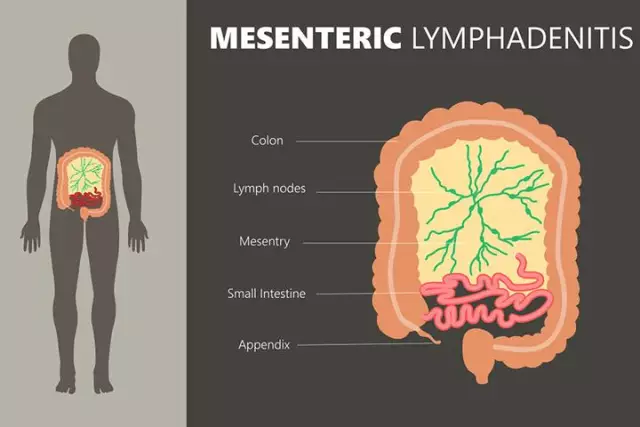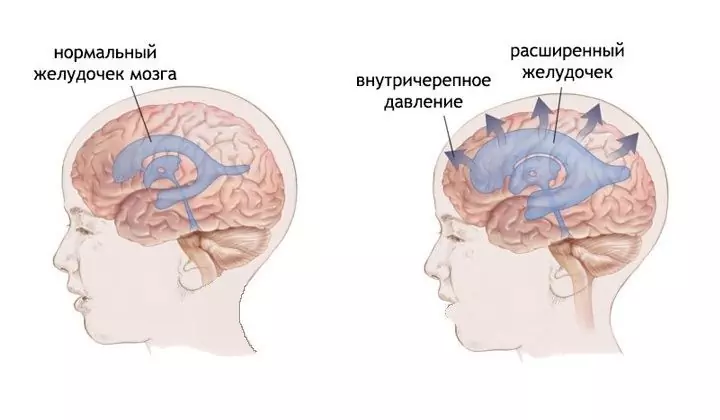- Author Rachel Wainwright [email protected].
- Public 2023-12-15 07:39.
- Last modified 2025-11-02 20:14.
Cervical lymphadenitis

Cervical lymphadenitis is an inflammation of the lymph nodes in the neck. It rarely occurs as an independent disease. Basically, it is a secondary manifestation of the spread of inflammatory processes in the body. The infection enters the cervical lymph nodes with the blood stream or through open wound surfaces.
The main signs of cervical lymphadenitis:
- Lumps on the neck, painful on palpation;
- Deterioration of general well-being;
- Temperature increase;
- Headache.
In the acute form of cervical lymphadenitis, strong suppuration of the lymph nodes is formed. Chronic lymphadenitis of the cervical region manifests itself with every illness with a cold or flu.
Cervical lymphadenitis: causes
The causes of cervical lymphadenitis are local or disseminated (disseminated) bactericidal infections. Depending on the localization of the source, they become inflamed:
- Submandibular lymph nodes - are affected by infection in the mouth and face;
- Pharyngeal lymph nodes - become infected with nasopharyngeal microorganisms;
- Superficial cervical lymph nodes - a consequence of infection of adjacent skin areas;
- All cervical lymph nodes, bilateral global inflammation - caused by infectious mononucleosis, toxoplasmosis, secondary syphilis, infiltrative lesions.
Recurrent lymphadenitis of the cervical region develops as a result of lymphogranulomatosis or immunodeficiency of the body.
The causes of cervical lymphadenitis can be such developing or transferred diseases and pathologies:
- Inflammation of the nasopharynx;
- Various allergic reactions;
- Metabolic disease;
- Connective tissue pathology;
- Dysfunction of the thyroid gland;
- Oncological diseases;
- Alcoholism;
- HIV infection.
Cervical lymphadenitis in children
Cervical lymphadenitis in children is more active than in adults. The children's immune system is just being formed and is not able to immediately cope with infection.
The chronic form of cervical lymphadenitis in children is manifested only by an increase in lymph nodes in the neck. When palpated, they are slightly painful or do not hurt at all. The temperature is normal, the child is feeling well.
The acute form of cervical lymphadenitis in children is manifested as follows:
- The temperature rises to 38 degrees and above;
- Sleep and appetite are disturbed;
- The child complains of headache, severe pain in places of enlarged lymph nodes;
- Strong swelling develops in the neck;
- In infants, general intoxication of the body is observed.
In this case, you should immediately contact a pediatrician who will determine the reasons and prescribe a course of treatment. In case of intoxication, it is urgent to take measures to stop it.
Self-medication or improper treatment can result in serious complications in the further development of the child.
Cervical lymphadenitis in adults

Cervical lymphadenitis in adults is a rather serious disease. The lymphatic system is one of the first to react to infections entering the body and signals an infection with an increase in lymph nodes. If seals are found in the cervical region, you should be examined by an otolaryngologist and dentist. Inflammation of the cervical lymph nodes in adults is formed due to:
- Various diseases of the respiratory system - acute respiratory infections, flu, tonsillitis, pneumonia, tuberculosis;
- Sluggish oral diseases - periodontal disease, caries, gingivitis;
- The presence of cancer cells (extremely rare).
Cervical lymphadenitis: treatment
Treatment of cervical lymphadenitis should begin with determining the root cause of infection and eliminating the infectious focus. After flu, tonsillitis, acute respiratory infections, lymph nodes return to normal without medication. In other cases, the doctor may prescribe anti-inflammatory drugs (prednisone, deltason, medrol).
In more serious stages, with inflammation and suppuration of the cervical lymph nodes, antibiotics are prescribed. The group of antibiotics depends on the spectrum of sensitivity of the infectious agent. If the infection was caused by a tuberculosis bacillus, treatment must be carried out in a hospital with special anti-tuberculosis therapy.
To speed up the process of treating cervical lymphadenitis, it is recommended:
- Various types of physiotherapy - drug electrophoresis, galvanization, UHF therapy;
- Anti-inflammatory ointments;
- Immunity restoring drugs - immunostimulants, multivitamins, drugs with a high content of vitamin C;
- Abundant drinking regimen and keeping the patient warm, without drafts and hypothermia.
If the treatment of cervical lymphadenitis has not yielded results and suppuration has formed in the lymph node, it must be opened. A surgical operation is performed, during which the suppuration is opened, the pus is removed and the wound is drained.
It is strongly not recommended to treat cervical lymphadenitis at home using folk methods. In most cases, this treatment is dangerous. Lymph nodes should not be warmed up, rubbed and applied to them with an iodine mesh. You can use tinctures or decoctions only after consulting your doctor.
Untimely treatment of cervical lymphadenitis can lead to thrombophlebitis or sepsis.
For prevention, you should follow basic rules of hygiene for cuts and injuries, carefully monitor your overall health and strengthen your immune system.
YouTube video related to the article:
The information is generalized and provided for informational purposes only. At the first sign of illness, see your doctor. Self-medication is hazardous to health!






